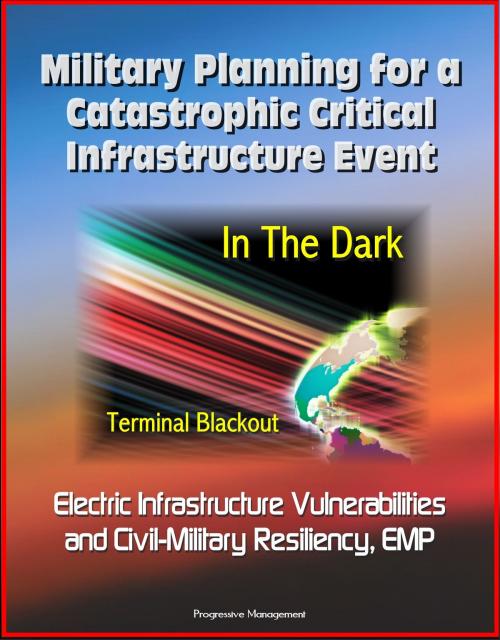Military Planning for a Catastrophic Critical Infrastructure Event: In the Dark, Terminal Blackout: Electric Infrastructure Vulnerabilities and Civil-Military Resiliency, EMP
Nonfiction, History, Military, United States, Social & Cultural Studies, Political Science, Government| Author: | Progressive Management | ISBN: | 9781310449567 |
| Publisher: | Progressive Management | Publication: | March 11, 2014 |
| Imprint: | Smashwords Edition | Language: | English |
| Author: | Progressive Management |
| ISBN: | 9781310449567 |
| Publisher: | Progressive Management |
| Publication: | March 11, 2014 |
| Imprint: | Smashwords Edition |
| Language: | English |
Two important reports from the U.S. Army's Strategic Studies Institute and Army War College discuss the terrible threat to civilization posed by damage to the electrical grid from electromagnetic pulse (EMP) attack or a solar storm.
For all but the last 150 years, the infrastructure constructed for better human living standards has been relatively unaffected by localized geological disasters or the broader effects of solar storms. But the harnessing of electrical power, begun in the mid-nineteenth century and its distribution via an interconnected grid to which 86% of the U.S. population is now connected, has created the potential for a near certain catastrophe of unprecedented proportion if it fails. The loss of electrical power and communications infrastructure for days, weeks, and more than a year are threat scenarios which could disintegrate the social, agricultural, and governmental fabric which makes a modern society possible today.
The most serious threat to the electric grid would be the destruction of power transformers which would take months or years to restore on a national scale. Similarly, not only can this destruction be produced by naturally occurring solar storms, but the same damaging effect can be replicated by a nuclear weapon and other man-made interference devices through malicious intent. A well-placed deliberate nuclear attack at high altitude by a hostile party can produce radiation emissions which can destroy a nation's critical infrastructure. Although there is nothing that can reduce the likelihood of solar flare activity, defense against a nuclear attack is part of national defense.
High-end cyberspace attacks, such as shutting down various supervisory control and data acquisition (SCADA) systems controlling power generation and distribution throughout the nation, offer a significant threat to critical infrastructure loss that must be defended against.
Threats to the electric grid (cyber, solar, non-nuclear electromagnetic pulse [NNEMP] and high-altitude nuclear electromagnetic pulse [HEMP]), as well as the potential consequences of significant damage to grid components by terrorists and other natural disasters, have increased incrementally since 2001; but details releasable to the public at the unclassified level were rare prior to 2008. Efforts by the Congressional Commission to Assess the Threat to the United States from Electromagnetic Pulse (EMP Attack) to declassify data relevant to American society within their final 2008 report were successful (albeit limited, as much remains classified), and subsequently heralded during a major conference at Niagara Falls, sponsored by a new non-profit non-partisan organization, which hosted highly influential experts and proponents of critical electric infrastructure protection.
Two important reports from the U.S. Army's Strategic Studies Institute and Army War College discuss the terrible threat to civilization posed by damage to the electrical grid from electromagnetic pulse (EMP) attack or a solar storm.
For all but the last 150 years, the infrastructure constructed for better human living standards has been relatively unaffected by localized geological disasters or the broader effects of solar storms. But the harnessing of electrical power, begun in the mid-nineteenth century and its distribution via an interconnected grid to which 86% of the U.S. population is now connected, has created the potential for a near certain catastrophe of unprecedented proportion if it fails. The loss of electrical power and communications infrastructure for days, weeks, and more than a year are threat scenarios which could disintegrate the social, agricultural, and governmental fabric which makes a modern society possible today.
The most serious threat to the electric grid would be the destruction of power transformers which would take months or years to restore on a national scale. Similarly, not only can this destruction be produced by naturally occurring solar storms, but the same damaging effect can be replicated by a nuclear weapon and other man-made interference devices through malicious intent. A well-placed deliberate nuclear attack at high altitude by a hostile party can produce radiation emissions which can destroy a nation's critical infrastructure. Although there is nothing that can reduce the likelihood of solar flare activity, defense against a nuclear attack is part of national defense.
High-end cyberspace attacks, such as shutting down various supervisory control and data acquisition (SCADA) systems controlling power generation and distribution throughout the nation, offer a significant threat to critical infrastructure loss that must be defended against.
Threats to the electric grid (cyber, solar, non-nuclear electromagnetic pulse [NNEMP] and high-altitude nuclear electromagnetic pulse [HEMP]), as well as the potential consequences of significant damage to grid components by terrorists and other natural disasters, have increased incrementally since 2001; but details releasable to the public at the unclassified level were rare prior to 2008. Efforts by the Congressional Commission to Assess the Threat to the United States from Electromagnetic Pulse (EMP Attack) to declassify data relevant to American society within their final 2008 report were successful (albeit limited, as much remains classified), and subsequently heralded during a major conference at Niagara Falls, sponsored by a new non-profit non-partisan organization, which hosted highly influential experts and proponents of critical electric infrastructure protection.















